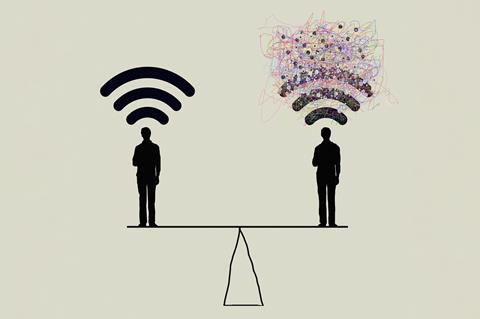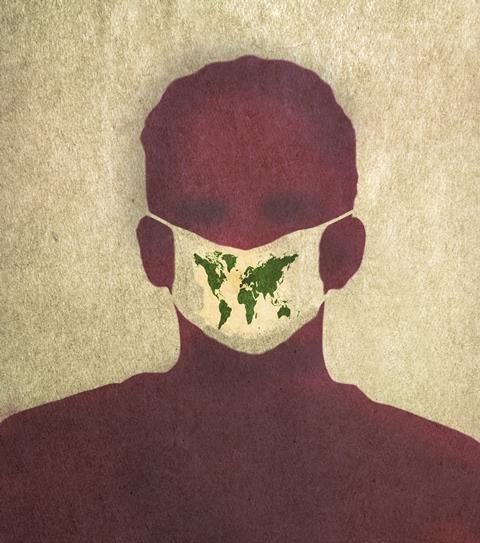Pandemic measures have exacerbated existing inequalities in academia
When Emmie Chiyindiko, a Zimbabwean chemist working at the University of the Free State in South Africa, logged into Blackboard to attend a virtual physical chemistry conference, she felt confident and well prepared. In an academic year disrupted by the Covid-19 pandemic, this was a golden opportunity for the PhD student to present her research on green materials. But just when it was time for her to start, Chiyindiko’s screen froze and the mic stopped working.
‘It was just one minute of glitching. [But] it felt like 10 minutes,’ she recalls. Nervous, she wondered whether the participants thought she hadn’t prepared well. Fortunately, the organisers allowed her to present again – and to her surprise, she won the second prize for the best PhD presentation.
Chiyindiko attended the conference from a personal computer in her room, which is in a part of the campus where internet speed is often spotty. Normally, she would have gone into the office to participate, but she has limited access to it because of Covid protocols. ‘To be honest, I wanted the first place [prize],’ says Chiyindiko. ‘So now you don’t really know if you’ve got second place because that other presentation was better or because of the glitches that happened.’
Still, this is a relatively small setback. As Covid-19 continues to change how chemistry is done and taught, many chemists from developing countries and underrepresented groups face bottlenecks that may alter their career paths forever.
Inequalities exacerbated

According to the International Telecommunication Union, 97% of Europeans are covered by 4G internet, while only 44% of the African population has that privilege. The virus deepened the existing digital divide, as researchers and students alike in developing countries struggled to move work online. Chiyindiko’s students at the Central University of Technology, Free State, where she is a lecturer, had to upload assignments on WhatsApp because most of them didn’t have high-speed internet at home.
Even across richer parts of the globe, academic chemists in certain areas struggled to impart knowledge. A 2018 Pew Research Center survey found that Black adolescents in the US are more likely than their white counterparts to face trouble doing homework because of the unavailability of internet or a computer. In fact, even Black professors often don’t have proper internet to teach classes, says Jalaal Hayes, an assistant professor in physical chemistry at Lincoln University of Pennsylvania, US, a historically Black university. Cultural norms also affect learning. ‘In a Black community, when you tell students to go home, they got responsibilities at home,’ says Hayes. ‘Their mom or dad would say, “Okay, you back home, it’s time to go get a job to help pay the bills, since you’re not in school.”’
Scientists around the world are fearing funding cuts, but in a May 2020 letter in Science, some researchers expressed concern that the Global South’s research capacity may be disproportionately affected by the pandemic. ‘There has been a huge shortage of money for research for the last six months. It is slowly starting to improve, but very slowly,’ says Arnab Bhattacharya, a professor of materials science/optoelectronics materials at Tata Institute of Fundamental Research in Mumbai, India, which is run by the Department of Atomic Energy, one of the many Indian ministries and departments that were allowed to spend only a fraction of their budget allocation this year. Supply chain issues induced by the global lockdown have made it harder for his lab to import high-tech materials such as reagents that are not available in India, he noted.
Even as things return to normal at his lab, Bhattacharya worries for Indian PhD students in his field who typically seek postdoc opportunities outside of India. With travel restrictions and impending funding cuts, these positions may dry up.
But even more devastating could be the lockdown-induced isolation. Typically, Chiyindiko’s lab has a motley mix of master’s students, doctoral candidates and postdocs. Having postdocs around is helpful to her because she can often clarify her doubts with them. Now, only a few people are allowed in the lab at any time because of Covid restrictions. ‘Already as a researcher, it’s kind of a lonesome journey … you are trying to do work that no one has ever done before,’ laments Chiyindiko. ‘So now, just that lack of support system makes you feel a lot less qualified and a lot less sure of yourself.’
Women bear the brunt
The pandemic has seen the lives of women, especially those with children, being turned upside down – and women in science were no exception. A preprint posted to bioRxiv in July 2020 found through an online survey of 3345 scientists in Brazil that the pandemic drastically affected the ability of female scientists to submit papers and meet deadlines. Female scientists with children were the worst affected, while men without children were affected the least. Another study published at a similar time in Nature Human Behaviour echoed the Brazilian findings: female scientists reported a 5% greater loss in research hours than their male counterparts. Parents of young children lost an additional 17% compared with non-parents.
‘My schedule was just incredible,’ says Lea Michel, an associate professor of chemistry and materials science at Rochester Institute of Technology (RIT) in New York, US. Michel had to juggle homeschooling two children along with her own virtual teaching load. At the same time, she shouldered the additional responsibility of attending to her students’ mental health needs. ’They gravitated towards me to talk about their problems. Of course, I made time for them. That’s an important part of my job,’ says Michel.
While tenure-clock extensions are a great thing, it may have long-term financial implications
Even with a supportive husband who shared quite a bit of her burden, Michel ended up having too much on her plate. As their daughters, aged seven and 10, were home and bored, she had to keep coming up with fun games to keep them constructively occupied. ‘It was like that perfect storm of all these new things, all of this change at once, and I really did bear a huge burden of that because I had young children,’ she says.
Like many other universities, RIT was supportive. It allowed flexible work arrangements and provided faculty members with a care.com subscription, which allows them to find babysitters and professionals for elderly care. Yet, Michel fears the coronavirus-induced disruption may change female scientists’ careers forever. Even before the pandemic, women in science had to pay a price for motherhood. In the US, mothers are 35% less likely to land a tenure-track spot than fathers.
Many universities have offered tenure-clock extensions to help researchers offset the damaging effects of the pandemic on their careers. ‘While this is a great thing, it may have long-term financial implications – delays in tenure mean a delay in a pay bump, which can have long-term ripple effects on people’s financial situations,’ says Michel. ‘I worry that certain faculty members from underrepresented groups (such as women and BIPOC[Black, Indigenous and people of colour]) may be forced to take disproportionate delays, further contributing to the pay gap that already exists.’
Academics renew calls for reforms

The pandemic has propelled researchers to speak up on inequalities in the scientific world. As it became clear that the novel coronavirus was affecting individuals from minority groups significantly – they are more likely to be hospitalised and die than white individuals – academics took to journals to highlight glaring racial disparities in science and medicine when it comes to representation across institutions and funding.
Disabled chemists are also fighting new battles. Krystal Vasquez, a PhD student in atmospheric chemistry at the California Institute of Technology, US, who has hypermobile Ehlers–Danlos syndrome, a connective tissue disorder, found herself spending an inordinate amount of time doing Covid-related social media advocacy that ate into her work hours. Vasquez was part of a student coalition that released a long report evaluating Caltech’s Covid-19 policies, urging university administrators to create safety protocols to protect disabled and chronically ill students, among other things.
But the disparities in who is doing this campaigning and other forms of service work might also be contributing to inequalities. ‘Women and BIPOC faculty members are often asked to do more service in order to create more diverse committees,’ explains Michel. ‘In a normal year, this can negatively affect their productivity; in a pandemic year, these types of time commitments are amplified and can have even more severe effects on productivity.’
At the start of the pandemic, Caryn Heldt, a professor of chemical engineering at Michigan Technological University in Houghton, Michigan, US, was appointed a technical lead at a clinical testing lab for Covid-19 at her university. This work has stolen considerable time from her main research on vaccines. She is disappointed, but her career is relatively immune to such disruptions as she is a full professor. ‘I’m extremely concerned about assistant professors,’ says Heldt, adding that pandemic-related administrative and service responsibilities could have potentially damaging effects for early-career women in her field.
Heldt calls for institutions to take note of this additional work. ‘Let’s take the opportunity that this [pandemic] has given us to maybe rethink and reshape a lot of our metrics,’ says Heldt. Some of the questions she wants institutions to ask include: Are we fairly evaluating everyone? Are we fairly distributing work? She wants universities to take into consideration service and mentoring work while evaluating faculty.
I’m hopeful that the pandemic has shown employers that a lot of work can easily be done from home
Even as uncertainties about their careers abound, researchers are finding some positive outcomes. For many disabled chemists, especially those with mobility issues, the pandemic brought some relief as they were able to attend classes and meetings from home. ‘I’m hopeful that the pandemic has shown employers that a lot of work can easily be done from home,’ says Vasquez, who finds prolonged walking and sitting difficult. ‘It takes up a lot of energy to commute to work. A lot of energy to sit upright in chairs. At home, if I need to work laying down for whatever reason, my bed or couch is right there.’
Yet, Vasquez isn’t completely optimistic: ‘I am worried that once the pandemic is over, universities and the like will begin to roll back all these accessibility features in an effort to return to normal and once again make science and academia inaccessible to disabled people.’
Some researchers are concentrating on the benefits that enforced breaks from their normal research has brought them. Heldt gained a tremendous amount of leadership experience spearheading the Sars-CoV-2 testing lab. ‘I don’t know how else I could have gotten this experience so fast,’ she says. And while Bhattacharya’s lab was shut, he created mask decontamination systems from discarded incubators at his institute. They are now in use at a cancer hospital and some dispensaries. ‘To be honest, I have written 100 plus papers in my career, but nothing has made me as satisfied as building something and seeing it in use in a hospital.’












No comments yet